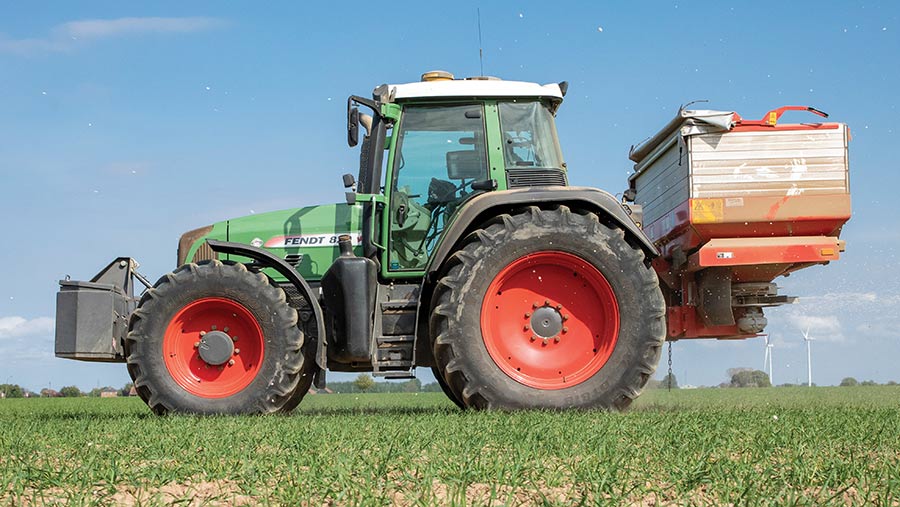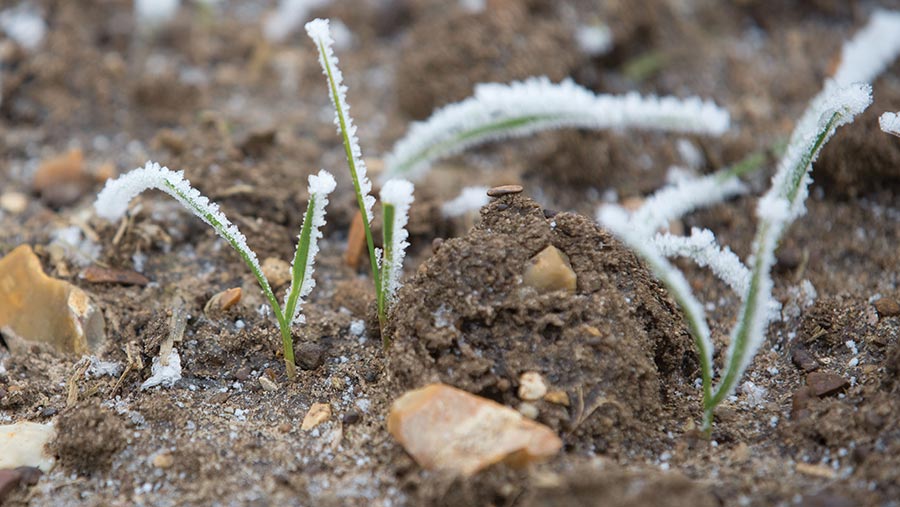Advice on backwards and poorly established crops this spring
 © GNP
© GNP An early dose of nitrogen to nurse backwards cereal crops into action will be key to optimising yield after crops battled intense rainfall this winter.
Soils could be carrying 40-60kg/ha less nitrogen than usual as a result of persistent rain leaching N through the soil profile.
Winter wheat growers are advised to apply 30-40kg N/ha early doors in February, as soon as conditions allow, to promote leaf growth, encourage tillering and stimulate root development.
Targeting crop nutrition to field requirements will be essential to optimise returns, while questions loom over the viability of poorly established crops carrying high grassweed burdens.
See also: Video: Three growers reveal impact of rain and plans for the spring
Little and often nitrogen
ProCam’s technical manager for the South, Paul Gruber, says growers should be reluctant to go “too hard, too soon” with nitrogen in case the weather turns wet again.
“Applying 30-40kg N/ha in February is enough to kick-start crops. Remember, the earlier you start applications, the more little and often you want to apply it,” he says.
However, if growers find they are not getting on the land until March, he recommends upping N rates to 60kg N/ha to fuel the hungry crops.
For winter barley, a heavier rate of 80kg N/ha is recommended, although he notes that up to half of total nitrogen can be applied in the first hit.
Incorporating sulphur into early N applications is essential for maximising efficacy.
Persist or write off crops?
Some crops have been knocked hard by waterlogging, which has left farmers questioning whether to persist with suboptimal plant counts.
“There are some difficult decisions to be made, but realistically, if crops are poorly established and full of blackgrass it is feasible to write them off,” says Paul.
But don’t be too hasty with these decisions.
“Identify the stage of grassweed development. If blackgrass weeds are smaller than the two- to three-leaf stage, residual chemistry options will still have a reasonable effect, so it is worth persisting with,” he says.
What’s more, winter wheat can compensate well from waterlogging as it has the ability to put on yield later in the season, assuming growers can get on early with nitrogen.
“For a minimum wheat plant population you’re looking at 80-100 plants/sq m, whereas for hybrid barley you can persevere with a population of 100 plants/sq m,” he says.
Consider herbicide cut-off dates when opting for a late herbicide spray. It may also be worth testing seed as herbicide resistance pressures build.
Targeting N for best return
Tailoring N requirements to what is in the field will be vital.
“Clearly, there is no point chucking money at bare ground,” says Paul, who suggests using variable-rate applications based on satellite imagery and green area index to target nitrogen investments.
Taking a soil mineral nitrogen test to verify how much N is available in the soil may also be beneficial, or growers could simply work out of the RB209, assuming a high overwinter rainfall category.
“Nitrogen remains one of the best inputs for return on crop yield. For potentially high-yielding crops we don’t want to restrict yield by overestimating how much residual nitrogen we have kicking about in the soil,” says Paul.
Disease, aphids and frost lift
Despite the doom and gloom, there are some well-developed crops out there. Following the relatively mild winter, the threat of disease could be considerable – particularly septoria in the South and West of England.
“We’ve had a few frosts to date but nothing terribly cold. If it continues to stay mild there will be a lot of disease carryover into the spring.
“Learning from last year, if this is the case again, we will need to hit crops hard with an early fungicide,” he says.
Similarly, barley yellow dwarf virus may be problematic as the mild winter promotes high populations of aphids, so keep an eye out for aphid alerts.

© Tim Scrivener
On the flip side, if we enter a prolonged cold spell, frost lift could be an issue. This is where waterlogged soils freeze and on expansion uproot small plants from the soil.
“In this scenario, a pass with the Cambridge rolls in the spring, when conditions allow, to physically reposition the soil back into place is an effective way to remedy crops that have been impacted,” says Paul.
Rooting
Crops in waterlogged soils often develop shallower, restricted root systems which limits the ability of the plant to scavenge for nutrients, increases vulnerability to drought and heightens lodging risk.
“Even if crops are well-established and well-tillered above ground, looks can be deceiving,” explains Nigel Scott, ProCam’s technical manager for the North.
“Digging up crops, we find that root systems are quite compromised. It will be a challenge managing crops accordingly to promote root mass.
“Timely nitrogen applications or a biostimulant spray at T0 or earlier could help promote root mass.”
Where root systems are severely compromised, growers may consider foliar feeding. Nigel recommends tissue analysis to optimise crop nutrition and supply crops with relevant trace elements.
Spring drilling: What to plant and when to do it
With little to no supply of spring seed, what are the options for growers who have had failed/flooded crops and are looking for an alternative?
Assuming growers still have winter wheat in the shed and they can catch the final vernalisation date, it is feasible for them to crack on with winter wheat drilling, especially as soils begin to dry.
“In many cases winter wheat remains the most profitable option and will keep rotations in place,” says Mike Thornton, ProCam head of crop production.
“Surplus spring cropping will no doubt drop prices back. If you’re not used to growing a lot of spring crops and conditions may not be optimal, is it really worth it?”
“If you’re considering alternatives such as linseed or oilseed rape, ask yourself: Are you familiar growing them? Is there a market? Will you make a good enough profit margin?”
What’s more, winter beans can still successfully be drilled in the spring as long as seed rates are cranked up accordingly and conditions allow, so this remains an option.
The Sustainable Farming Incentive continues to entice farmers with its guaranteed income.
When to drill spring crops
Spring cropping experience tells us not to rush in, but yield data often suggests the opposite. However, spring crops only perform well when planted in the right seed-bed conditions.
Mike says: “Thinking back to last year, spring barley drilled in February yielded particularly well, up to 7-8t/ha, while March drilled crops were hit by rain and April was dry.
“I think farmers will be looking to replicate an early drilled February crop again.”

